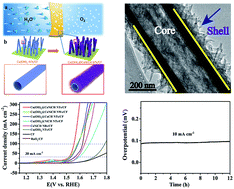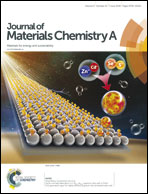Tubular Cu(OH)2 arrays decorated with nanothorny Co–Ni bimetallic carbonate hydroxide supported on Cu foam: a 3D hierarchical core–shell efficient electrocatalyst for the oxygen evolution reaction†
Abstract
Developing highly efficient and low-cost oxygen evolution reaction (OER) electrocatalysts is highly demanded, as the OER is recognized as a key half-reaction in water splitting for producing hydrogen; however, this still remains a great challenge. Herein, we design three-dimensional (3D) tubular hierarchical core–shell electrocatalysts for the OER using a simple and highly controllable two-step method. The large-scale tubular Cu(OH)2 arrays are directly grown on Cu foam (CF) at room temperature, followed by the growth of highly porous CoNi carbonate hydroxides (CH) via a low-temperature hydrothermal method on the walls of these Cu(OH)2 nanotubes (NTs). The hollow and open-structured core–shell hierarchical Cu(OH)2@CoNiCH NTs/CF electrode with a large surface area and numerous mesoporous and short diffusion paths can provide many active sites, fast electron transport and easy accessibility of water, leading to an excellent OER activity in an alkaline electrolyte with an overpotential of 288 mV and 326 mV at a current density of 30 mA cm−2 and 100 mA cm−2, respectively, also with robust durability. This new structure would open an avenue for the advancement of highly efficient OER electrocatalysts.



 Please wait while we load your content...
Please wait while we load your content...